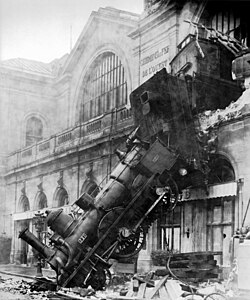


A railway accident (also known as a train accident,train wreck, and train crash) is a type of disaster involving one or more trains. Train wrecks often occur as a result of miscommunication, for example when a moving train meets another train on the same track, when the wheels of train come off the track, or when a boiler explosion occurs. Train accidents have often been widely covered in popular media and in folklore. A head-on collision between two trains is colloquially called a "cornfield meet" in the United States. [1]
Contents
- Types of accidents
- Collisions
- Derailments
- Other
- Causes of accidents
- Driver error
- Signalman error
- Rolling stock failure
- Civil engineering failure
- Other people
- Natural causes
- Contributory factors
- See also
- References
- Bibliography
- Further reading
- External links
The classification of railway accidents—both in terms of cause and effect—is a valuable aid in studying railway accidents in order to help to prevent similar ones occurring in the future. Systematic investigation for over 150 years has led to the railways' excellent safety record (compared, for example, with road transport).
Ludwig von Stockert (1913) proposed a classification of accidents by their effects (consequences) – e.g., head-on-collisions, rear-end collisions, derailments. Schneider and Mase (1968) proposed an additional classification by causes – e.g., driver's errors, signalmen's errors, mechanical faults. Similar categorisations had been made by implication in previous books e.g. Rolt (1956), but Stockert's and Schneider/Mase's are more systematic and complete. With minor changes, they represent best knowledge.